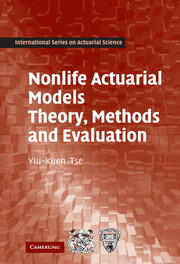Book contents
- Frontmatter
- Contents
- Preface
- Notation and convention
- Part I Loss models
- Part II Risk and ruin
- Part III Credibility
- Part IV Model construction and evaluation
- 10 Model estimation and types of data
- 11 Nonparametric model estimation
- 12 Parametric model estimation
- 13 Model evaluation and selection
- 14 Basic Monte Carlo methods
- 15 Applications of Monte Carlo methods
- Appendix: Review of statistics
- Answers to exercises
- References
- Index
12 - Parametric model estimation
from Part IV - Model construction and evaluation
Published online by Cambridge University Press: 05 June 2012
- Frontmatter
- Contents
- Preface
- Notation and convention
- Part I Loss models
- Part II Risk and ruin
- Part III Credibility
- Part IV Model construction and evaluation
- 10 Model estimation and types of data
- 11 Nonparametric model estimation
- 12 Parametric model estimation
- 13 Model evaluation and selection
- 14 Basic Monte Carlo methods
- 15 Applications of Monte Carlo methods
- Appendix: Review of statistics
- Answers to exercises
- References
- Index
Summary
Some models assume that the failure-time or loss variables follow a certain family of distributions, specified up to a number of unknown parameters. To compute quantities such as the average loss or VaR, the parameters of the distributions have to be estimated. This chapter discusses various methods of estimating the parameters of a failure-time or loss distribution.
Matching moments and percentiles to the data are two simple methods of parametric estimation. These methods, however, are subject to the decisions of the set of moments or percentiles to be used. The most important estimation method in the classical statistics literature is perhaps the maximum likelihood estimation method. It is applicable to a wide class of problems: variables that are discrete or continuous, and data observations that are complete or incomplete. On the other hand, the Bayesian approach provides an alternative perspective to parametric estimation, and has been made easier to adopt due to the advances in computational techniques.
Parametric models can be extended to allow the distributions to vary with some attributes of the objects, such as the years of driving experience of the insured in predicting vehicle accident claims. This gives rise to the use of models with covariates. A very important model in the parametric estimation of models with covariates is Cox's proportional hazards model.
We also include in this chapter a brief introduction to the use of copula in modeling the joint distributions of several variables.
- Type
- Chapter
- Information
- Nonlife Actuarial ModelsTheory, Methods and Evaluation, pp. 335 - 379Publisher: Cambridge University PressPrint publication year: 2009

